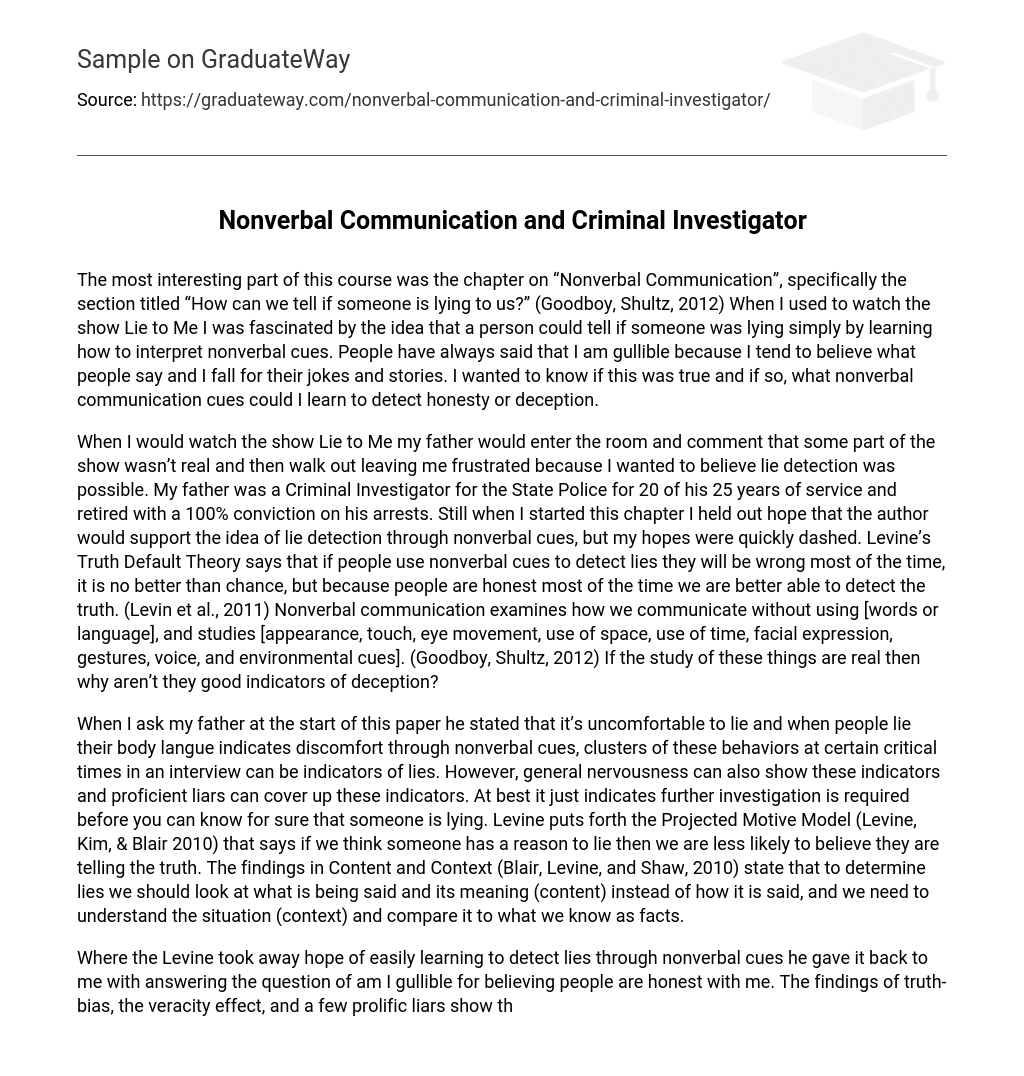The most interesting part of this course was the chapter on “Nonverbal Communication”, specifically the section titled “How can we tell if someone is lying to us?” (Goodboy, Shultz, 2012) When I used to watch the show Lie to Me I was fascinated by the idea that a person could tell if someone was lying simply by learning how to interpret nonverbal cues. People have always said that I am gullible because I tend to believe what people say and I fall for their jokes and stories. I wanted to know if this was true and if so, what nonverbal communication cues could I learn to detect honesty or deception.
When I would watch the show Lie to Me my father would enter the room and comment that some part of the show wasn’t real and then walk out leaving me frustrated because I wanted to believe lie detection was possible. My father was a Criminal Investigator for the State Police for 20 of his 25 years of service and retired with a 100% conviction on his arrests. Still when I started this chapter I held out hope that the author would support the idea of lie detection through nonverbal cues, but my hopes were quickly dashed. Levine’s Truth Default Theory says that if people use nonverbal cues to detect lies they will be wrong most of the time, it is no better than chance, but because people are honest most of the time we are better able to detect the truth. (Levin et al., 2011) Nonverbal communication examines how we communicate without using [words or language], and studies [appearance, touch, eye movement, use of space, use of time, facial expression, gestures, voice, and environmental cues]. (Goodboy, Shultz, 2012) If the study of these things are real then why aren’t they good indicators of deception?
When I ask my father at the start of this paper he stated that it’s uncomfortable to lie and when people lie their body langue indicates discomfort through nonverbal cues, clusters of these behaviors at certain critical times in an interview can be indicators of lies. However, general nervousness can also show these indicators and proficient liars can cover up these indicators. At best it just indicates further investigation is required before you can know for sure that someone is lying. Levine puts forth the Projected Motive Model (Levine, Kim, & Blair 2010) that says if we think someone has a reason to lie then we are less likely to believe they are telling the truth. The findings in Content and Context (Blair, Levine, and Shaw, 2010) state that to determine lies we should look at what is being said and its meaning (content) instead of how it is said, and we need to understand the situation (context) and compare it to what we know as facts.
Where the Levine took away hope of easily learning to detect lies through nonverbal cues he gave it back to me with answering the question of am I gullible for believing people are honest with me. The findings of truth-bias, the veracity effect, and a few prolific liars show that my trusting people puts me in the majority of people. Truth-bias states that most people tend to believe others are being honest with them most of the time. (Levine, Park &McCormack, 1999) The veracity effect (Levine, Park &McCormack, 1999) says that if people are telling the truth they will be believed more often which increases the odds of detecting the truth at more than just chance. Finally, the findings in a few prolific liars (Serota, Levine, & Boster, 2010) show that most people are telling the truth most of the time and only a small amount of people lie a great deal.
I must conclude that people can’t tell if someone if lying based on just nonverbal communication. Nonverbal cues can be used as indicators of doubt which should lead to further investigation of motive, known facts, and the context in which the statements were made. I also conclude that I am not gullible; believing people are being honest with me most of the time makes me above average at detecting the truth and better at it than the cynics.





